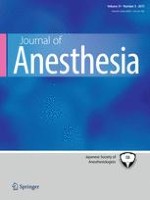Erschienen in:

08.08.2017 | Original Article
Electroencephalographic effect of age-adjusted 1 MAC desflurane and sevoflurane in young, middle-aged, and elderly patients
verfasst von:
Shinya Kanazawa, Yutaka Oda, Chika Maeda, Ryu Okutani
Erschienen in:
Journal of Anesthesia
|
Ausgabe 5/2017
Einloggen, um Zugang zu erhalten
Abstract
Purpose
We examined the hypothesis that 1 minimum alveolar concentration (MAC) of desflurane and sevoflurane provides different depth of anesthesia.
Methods
One hundred and twenty young (20–30 years), middle-aged (31–65 years), and elderly (66–80 years) patients were randomly allocated to receive either desflurane or sevoflurane (n = 20, each group). General anesthesia was induced with propofol 2 mg/kg bolus and remifentanil 0.25 µg/kg/min, which was stopped after tracheal intubation. Maintenance of anesthesia was started with an end-tidal concentration of desflurane or sevoflurane at age-adjusted 1 MAC and maintained for 10 min, followed by 1-min assessment of bispectral index (BIS), 95% spectral edge frequency (SEF95), and amplitude of the electroencephalogram taken at 10-s intervals.
Results
BIS and SEF95 in patients receiving 1 MAC desflurane were significantly lower than those receiving 1 MAC sevoflurane including all age groups [35 (29, 39) vs. 41 (38, 49); 12.53 (10.99, 13.95) Hz vs. 14.42 (12.99, 17.17) Hz median (25, 75 percentile), respectively, P < 0.001 for both]. Both BIS and SEF95 in young patients were lower than in middle-aged and elderly patients receiving either desflurane or sevoflurane (P < 0.001 for both). There were no differences in amplitude between patients receiving desflurane and sevoflurane.
Conclusions
BIS as well as SEF95 were lower in patients receiving 1 MAC desflurane than those receiving 1 MAC sevoflurane, suggesting that desflurane provides higher depth of anesthesia than sevoflurane at 1 MAC.